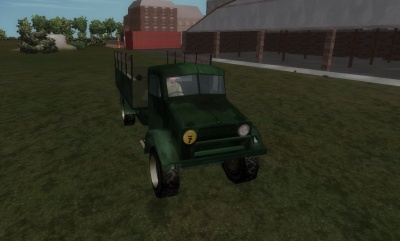Difference between revisions of "Bedford OYD"
| Line 31: | Line 31: | ||
=Game Play= | =Game Play= | ||
[[Category:Trucks and Prime Movers]] | [[Category:Trucks and Prime Movers]] | ||
Latest revision as of 05:44, 26 July 2023
History

| |
| Bedford OYD | |
| Specifications | |
| Type | 3-ton Truck |
| Maximum Speed | 70 km/h |
Even before it felt the sting of Blitzkrieg, the British Army had devised a doctrine that called for tanks to penetrate enemy lines while infantry followed up to consolidate gains. If, however, the tanks raced ahead too quickly for troops to keep up, they might win a great deal of ground but not hold it for any length of time. The army needed to make infantry fast and mobile, and the answer was trucks. Throughout the war, Britain relied primarily on the four-wheeled, two-wheel-drive Bedford OY series that could haul up to 8,500 lb (3,800 kg) despite its three-ton (3,000 kg) designation.
In 1923, General Motors (GM), an American company, sold its first truck, a Chevrolet, in the U.K. Two years later, GM bought Vauxhall Motors and in 1931 started producing the Bedford brand of trucks with Vauxhall’s assembly lines. Bedford trucks had become a popular and respected breed by the mid 1930s: sales broke 30,000 units in 1937.
When war broke out in 1939, the War Department controlled some 85,000 vehicles, including more than 26,000 it had shanghaied from civilians. Vauxhall, in the meantime, was casually developing a 4x4 military truck and while war hurried the development process, production geared up to produce Bedford 4x2s, including more of the OY family.
The Bedford OY was a commercial design made ready for service with simplified bodywork and single rear tires. Early-war models had wooden rear bodies. More OYs were produced during the war than any other British three-ton truck, numbering more than 72,000 of all the 250,000 Bedford trucks made.
The OY series, in particular the "Truck, Three-Ton, 4X2, Bedford OYD" general-service truck, played a variety of roles: mobile workshop; office; and transporter of troops, machine guns, and supplies. The Bedford OYC tanker carried 800 Imp gal (3,637 L) of fuel. The Armadillo was a Bedford OYD (or another truck) that carried a wooden pillbox with pebble-filled, double-wall "armour" mounted on the back. Some 660 Armadillos were built in 1940. Several trucks in this class also served as radio-laden command vehicles.
Just about the only thing the two-wheel-drive Bedford OY couldn’t do was tow a decent-sized gun; four-wheel-drive was needed for that. Obviously, Bedford drivers tried to limit front-line exposure as much as possible.
The British Army used the Bedford OY throughout the war, in all theaters. So, for that matter, did the Wehrmacht. German forces captured many Bedfords after the Dunkirk retreat and added more in Greece. Numerous pictures exist of gray Bedfords serving German masters on the Russian front.
In Battleground Europe, the Bedford OYD is used for general troop transport, towing the lighter anti-tank and anti-aircraft guns, and, of course, as a means to create a mobile spawn point (MSP) for British forces in the forward parts of the battlefield. An MSP can also be used as a remote defensive spawn point away from the town currently being defended from attack.